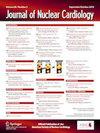心率和血压对瑞加登诺森压力反应的预后作用
IF 3
4区 医学
Q2 CARDIAC & CARDIOVASCULAR SYSTEMS
引用次数: 0
摘要
背景:尽管对雷公藤多苷应激的心率反应(HRR)已被证明是预测预后的有力指标,但尚未在大规模的所有患者队列中进行调查。与心率反应相比,收缩压反应(SBPR)的预后效用尚未得到研究:在一个回顾性队列中,10227 名患者接受了雷公藤多苷应激 SPECT 心肌灌注成像(MPI),HRR 和 SBPR 的计算公式为 100*(峰值充血值-基线值)/基线值。在 35±21 个月的随访期间,共观察到 921 例(8.8%)死亡病例。中位 HRR 为 35%(四分位距 [IQR],21% 至 51%)。中位 SBPR 为 -9%(IQR,-17% 至 -2%)。HRR 和 SBPR 与全因死亡率独立相关,HRR 每增加 1%,调整后的危险比 [HR] 为 0.980(CI,0.977-0.984),SBPR 每增加 1%,调整后的危险比 [HR] 为 0.994(CI,0.988-0.999)。死亡率随着 HRR 四分位数和 SBPR 四分位数的降低而增加。HRR 对全因死亡率的预后价值高于临床和影像学参数(曲线下面积 [AUC] 增加,0.03;PC 结论:在接受压力 MPI 的患者中,对雷公藤多苷的 HRR 受损对全因死亡率具有独立的增量预后价值,超过了临床、成像和 SBPR 数据。SBPR 与 HRR 呈正相关,但不提供增量预后效用。在评估患者的总体风险时,应常规报告 HRR,而不是 SBPR。HRR 异常阈值小于 20% 可以改善风险分层。本文章由计算机程序翻译,如有差异,请以英文原文为准。
The prognostic utility of heart rate and blood pressure response to regadenoson stress
Background
Although heart rate response (HRR) to regadenoson stress has been shown to be a strong predictor of outcome, it has not been investigated in a large all-comers cohort. The prognostic utility of systolic blood pressure response (SBPR) has not been investigated in comparison with HRR.
Methods and results
In a retrospective cohort of 10,227 patients undergoing regadenoson stress single-photon emission computed tomography myocardial perfusion imaging (MPI), HRR, and SBPR were calculated as 100×(peak hyperemia value–baseline value)/baseline value. During 35 ± 21 months follow-up, 921 (8.8%) deaths were observed. The median HRR was 35% (interquartile range [IQR], 21% to 51%). The median SBPR was −9% (IQR, −17% to −2%). HRR and SBPR were independently associated with all-cause mortality with adjusted hazard ratio [HR] of .980 per 1% increment in HRR (CI, .977-.984) and .994 per 1% increment in SBPR (CI, .988-.999). Mortality rates increased with decreasing HRR quartile and SBPR tertile. HRR provided incremental prognostic value for all-cause mortality beyond clinical and imaging parameters (area under the curve [AUC] increase, .03; P < .001) and SBPR data (AUC increase, .11; P < 0001). SBPR did not provide significant incremental prognostic value beyond clinical and imaging parameters or HRR data. We derived and validated HRR of <20% as a cut-off that can improve risk stratification beyond clinical and MPI findings.
Conclusion
Among patients undergoing stress MPI, impaired HRR to regadenoson provided independent and incremental prognostic value for all-cause mortality beyond clinical, imaging, and SBPR data. SBPR positively correlates with HRR, but it does not provide incremental prognostic utility. HRR, but not SBPR, should be routinely reported and considered in assessing patients' overall risk. An abnormal HRR threshold of <20% can improve risk stratification.
求助全文
通过发布文献求助,成功后即可免费获取论文全文。
去求助
来源期刊
CiteScore
5.30
自引率
20.80%
发文量
249
审稿时长
4-8 weeks
期刊介绍:
Journal of Nuclear Cardiology is the only journal in the world devoted to this dynamic and growing subspecialty. Physicians and technologists value the Journal not only for its peer-reviewed articles, but also for its timely discussions about the current and future role of nuclear cardiology. Original articles address all aspects of nuclear cardiology, including interpretation, diagnosis, imaging equipment, and use of radiopharmaceuticals. As the official publication of the American Society of Nuclear Cardiology, the Journal also brings readers the latest information emerging from the Society''s task forces and publishes guidelines and position papers as they are adopted.

 求助内容:
求助内容: 应助结果提醒方式:
应助结果提醒方式:


